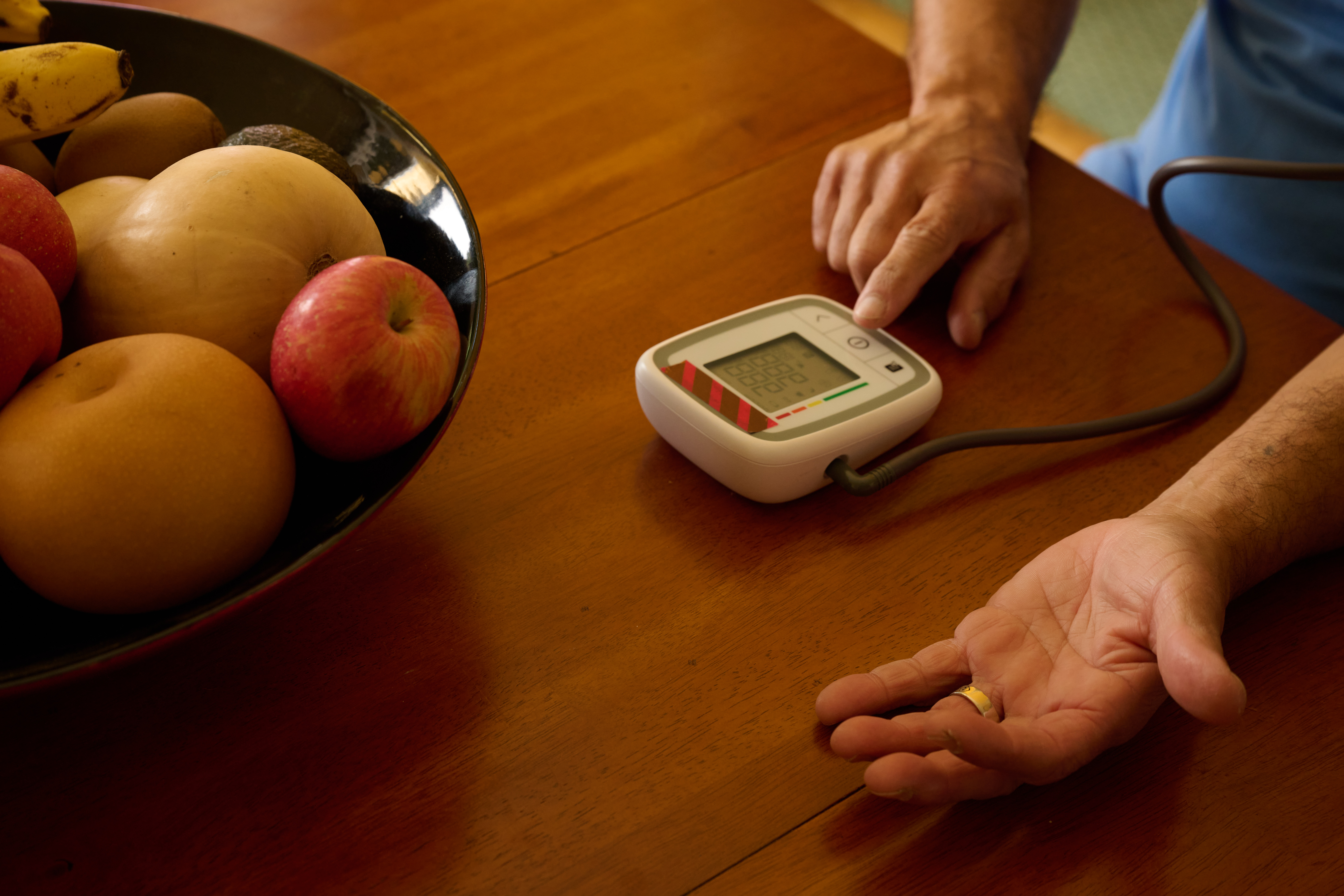Research Highlights:
- Adults in rural villages in China who participated in the Healthy Family Program, a family-based intervention that involved regular blood pressure monitoring, the use of low-sodium salt substitutes and educational sessions on healthy lifestyle habits, achieved an average of 10 mm Hg reduction in systolic blood pressure compared to adults who did not participate in the program.
- Six months after the program ended, the average systolic blood pressure for people who lived in participating villages remained 3.7 mm Hg lower compared to people who did not participate in the program, suggesting that they maintained the healthy habits they had developed during the program—and that this family-based intervention could be effective in reducing blood pressure for people in rural or under-resourced communities.
- Note: The study featured in this news release is a research abstract. Abstracts presented at American Heart Association’s scientific meetings are not peer-reviewed, and the findings are considered preliminary until published as a full manuscript in a peer-reviewed scientific journal.
Embargoed until 4:15 p.m. CT/5:15 p.m. ET, Sunday, Nov. 9, 2025
This news release contains updated information from the research authors that was not in the abstract.
NEW ORLEANS, LA - November 9, 2025 (NEWMEDIAWIRE) - New research found family support helped adults in rural China reduce their blood pressure. Participants in a six-month, family-based program that included regular blood pressure monitoring, the use of low-sodium salt substitutes and educational classes on healthy lifestyle habits reduced their systolic blood pressure (the top number) by an average of 10 mm Hg compared to people who did not participate in the program, according to a preliminary late-breaking science presentation today at the American Heart Association’s Scientific Sessions 2025. The meeting, Nov. 7-10, in New Orleans, is a premier global exchange of the latest scientific advancements, research and evidence-based clinical practice updates in cardiovascular science.

The Healthy Family Program was conducted in 80 villages throughout rural China, with approximately 30-50 families in each village. Half of the villages were randomly assigned to receive a family-focused intervention with multiple strategies to help lower blood pressure. Residents aged 40-80 years within participating families were eligible.
“Most blood pressure programs focus on treatment for people with high blood pressure, whereas our study included the whole family regardless of their blood pressure levels,” said Professor Xin Du, M.D., Ph.D., co-principal investigator of the study, director of the Center of Heart Failure and Cardiomyopathy at Beijing Anzhen Hospital, Capital Medical University and director of the Ruyang Rural Health Institute.
In the participating villages, local health workers received training sessions to become family health instructors. As instructors, they trained one person from each household to become a “family leader” implementing the Healthy Family Program within the family.
Each participating family received a free blood pressure monitoring device and access to a smartphone app that provided automatic feedback on blood pressure readings and recommendations on when to seek medical care. Each family leader was responsible for regularly monitoring family members’ blood pressure and entering the measurements into the app. People in participating villages also received free low-sodium, potassium-enriched salt substitutes to replace regular cooking salt and for use at the table with meals.
Family members without diagnosed high blood pressure also participated in the program. If their initial blood pressure measurement was normal (below 120/80 mm Hg), they were instructed to measure it again in three months. They were also encouraged to follow a diet prepared with the low-sodium salt, participate in group exercises and monitor their weight monthly.
The community health instructors and family leaders worked together to promote healthy lifestyles for all family members. The health instructors organized educational sessions for the family leaders on healthy lifestyle habits such as reducing salt intake, weight management, physical exercise and blood pressure control. After six months, the educational sessions and free salt substitutes were no longer provided in order to test whether the family members could independently maintain healthy lifestyle habits. The digital app, blood pressure monitoring devices and body weight scales remained available for participating families to continue using.
The study’s key findings include:
- Adults who lived in participating villages achieved an average 10 mm Hg reduction in systolic blood pressure during the six months of the support program compared to people who lived in villages that did not participate.
- Six months after the program ended, the average systolic blood pressure for people who lived in participating villages remained 3.7 mm Hg lower compared to people who did not participate in the program, suggesting that they maintained some healthy habits they had developed during the program.
“In many cultures, families share the responsibility of caring for one another and promoting a healthy lifestyle. In our study, family leaders played a critical role in implementing the program by supporting a healthy diet high in vegetables, fruits and legumes, and low in sodium, fat and sugar. This is crucial for managing blood pressure, as well as for preventing other chronic health conditions, such as obesity and Type 2 diabetes,” Du said.
Study details, background and design:
- The study included 8,001 adults, ages 40-80 years old, living in 80 villages throughout rural Mainland China.
- Half of the villages were assigned to receive the Healthy Family Program family-based intervention for six months, including a free home blood pressure monitor and low-sodium salt substitutes. Family leaders performed regular blood pressure monitoring and encouraged family members to participate in group exercises and educational sessions on healthy diet and weight management.
- Participants with initial blood pressure readings of 160/100 mm Hg or higher were required to measure their blood pressure the following day; those with readings of 140-159/90-99 mm Hg were instructed to measure within one week; and those with readings below 120/80 mm Hg were instructed to repeat measurement every three months.
- Adult family members with terminal illnesses (such as advanced cancer, advanced heart disease or end-stage kidney disease) or pregnancy plans were excluded from the study.
“This approach could transform how we prevent heart disease in communities worldwide. By involving entire families and communities rather than treating individuals, we can likely reduce everyone’s risk of heart attack and stroke, especially in areas where health care resources are limited,” Du said.
Study limitations:
- Researchers conducted the study in rural China, so more research is needed to determine if these results apply to other populations and health care systems.
- The intervention lasted only six months, which was not long enough to measure actual reductions in heart attack, stroke or death from heart disease.
- Some people who lived in the participating villages moved to cities for work during the study period and were not present for all of the intervention strategies, which may have affected the results.
- The program required support from the local government for recruitment and coordination, which may be necessary for successful implementation in other communities.
Co-authors, disclosures and funding sources are listed in the manuscript.
Statements and conclusions of studies that are presented at the American Heart Association’s scientific meetings are solely those of the study authors and do not necessarily reflect the Association’s policy or position. The Association makes no representation or guarantee as to their accuracy or reliability. Abstracts presented at the Association’s scientific meetings are not peer-reviewed, rather, they are curated by independent review panels and are considered based on the potential to add to the diversity of scientific issues and views discussed at the meeting. The findings are considered preliminary until published as a full manuscript in a peer-reviewed scientific journal.
The Association receives more than 85% of its revenue from sources other than corporations. These sources include contributions from individuals, foundations and estates, as well as investment earnings and revenue from the sale of our educational materials. Corporations (including pharmaceutical, device manufacturers and other companies) also make donations to the Association. The Association has strict policies to prevent any donations from influencing its science content and policy positions. Overall financial information is available here.
Additional Resources:
- Multimedia is available on the right column of the release link.
- View the abstract in the American Heart Association Scientific Sessions 2025 Online Program Planner
- American Heart Association news release: Target: BP initiative helps more than 10M adults with hypertension (Sept. 2025)
- American Heart Association Scientific Statement news release: New high blood pressure guideline emphasizes prevention, early treatment to reduce CVD risk (Aug. 2025)
- American Heart Association news release: Heart disease remains leading cause of death as key health risk factors continue to rise (Jan. 2025)
- American Heart Association health information: High Blood Pressure
- About Scientific Sessions 2025
- For more news at AHA Scientific Sessions 2025, follow us on X @HeartNews, #AHA25
###
About the American Heart Association
The American Heart Association is a relentless force for a world of longer, healthier lives. Dedicated to ensuring equitable health in all communities, the organization has been a leading source of health information for more than one hundred years. Supported by more than 35 million volunteers globally, we fund groundbreaking research, advocate for the public’s health, and provide critical resources to save and improve lives affected by cardiovascular disease and stroke. By driving breakthroughs and implementing proven solutions in science, policy, and care, we work tirelessly to advance health and transform lives every day. Connect with us on heart.org, Facebook, X or by calling 1-800-AHA-USA1.
For Media Inquiries and American Heart Association Expert Perspective:
American Heart Association Communications & Media Relations in Dallas: 214-706-1173;ahacommunications@heart.org
Amanda Ebert: Amanda.Ebert@heart.org
For Public Inquiries: 1-800-AHA-USA1 (242-8721)
heart.org and stroke.org





